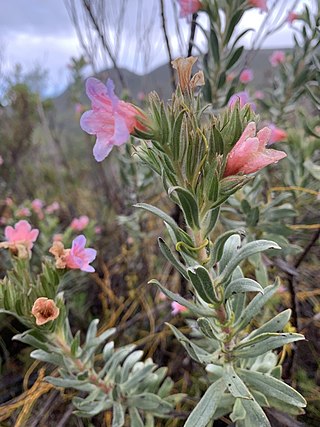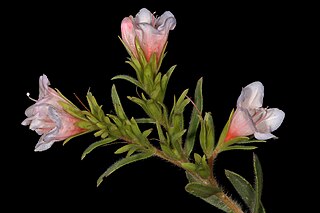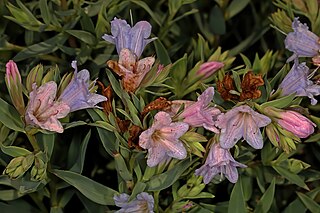Description
This shrublet grows 50–100 cm (1.6–3.3 ft) tall. The stalkless leaves are hairy near the tips. [1] They are narrow and oblong in shape. [2]
Funnel-shaped flowers are present between August and October. [1] [2] They are blue with hairs on the outside and are borne in cymes. [1] The flower buds are loosely arranged to form a globose unit, spreading slightly as they mature. There at least three flowers per cymule. [2] Each flower is 17–30 mm (0.67–1.18 in) long, with the anterior petal lobes being larger than the rest. [2] The anthers are borne on short filaments and the stamens only rarely protrude past the petals. [2] The staminal scales are ridge-like and do not have lateral lobes. [1] They occur well below the throat of the corolla tube, being inserted about 4.5–5 mm (0.18–0.20 in) above the base. [2]
This species has been confused with Lobostemon marlothii . There are, however a few features that can be used to distinguish between the two. Lobostemon decorus has a longer calyx, fewer flowers per inflorescence, pale blue flowers (compared to deep blue with a pinkish base in L. marlothii) and narrowly oblong leaves (compared to the wider and often more lance-like leaves in L. marlothii). [2]

Disa purpurascens is a species of orchid found in South Africa. It is also known as the early blue disa or the bloumoederkappie.

Moraea aristata is a species of flowering plant in the family Iridaceae. It is referred to by the common names blue-eyed uintjie or Blouooguintjie in Afrikaans.It is endemic to the city of Cape Town and is considered to be critically endangered.

Wahlenbergia capensis, commonly known as the Cape bluebell, is a plant in the family Campanulaceae and is native to the Cape Province but has been introduced to Australia. It is an annual herb with up to four greenish blue, bell-shaped flowers with spreading petal lobes.

Lobostemon is a genus of flowering plants belonging to the family Boraginaceae. It is endemic to the Cape Provinces of South Africa. The majority of species are limited to the winter rainfall area of the country, from Springbok to Mossel Bay. In Afrikaans these species are known as agtdaegeneesbos, or loosely translated, bush that will heal in eight days. As this name suggests, many species have medicinal properties. This is best known from Lobostemon fruticosus, which is used for treating wounds, blood poisoning, ringworm, skin diseases and syphilis.

Lobostemon montanus, the turquoise bush bugloss, mountain lobostemon or agtdaegeneesbos, is a South African species belonging to the forget-me-not family.

Lobostemon argenteus, or the silver healthbush, blue rocket bugloss or disselblaarluibos, is a species in the forget-me-not family that is endemic to South Africa.

Lobostemon belliformis, the Gouriqua lobostemon or beaut healthbush, is a critically endangered species in the forget-me-not family. It is known from a single locality on the Riversdale Plain in South Africa.

Lobostemon capitatus is a species belonging to the forget-me-not family. It is endemic to the Western Cape of South Africa, where it is found between Porterville and Bredasdorp.

Lobostemon curvifolius, the largeflower healthbush, is a species of the forget-me-not family from South Africa.
Lobostemon collinus, the pyjamabush or iron healthbush, is a species belonging to the forget me not family. It is known only from the fynbos biome of the Western Cape of South Africa.
Lobostemon cinereus, the ash healthbush, is a species belonging to the forget-me-not family. It is endemic to the Cape Provinces of South Africa.
Lobostemon daltonii, the Infanta healthbush, is a species of the forget-me-not family endemic to the Cape Provinces of South Africa.
Lobostemon echioides, the common healthbush, is the mostly widely distributed species in its genus. It is endemic to the Cape Provinces of South Africa, where it is found growing between Namaqualand and the Karoo and the Eastern Cape.

Lobostemon fruticosus, also known as the eightday healthbush or pyjamabush, is a species of medicinal plant endemic to the Cape Provinces of South Africa. It is considered to be ecologically and economically important but is declining due to overexploitation.
Lobostemon glaber, the renoster healthbush, is a species of plant from South Africa. It is in the forget-me not family.

Lobostemon glaucophyllus, the smooth-leaved bush bugloss or grey healthbush, is a South African plant species belonging to the forget-me-not family. It is endemic to South Africa's Cape Provinces.
Acrodon deminutus, also known as the Malgas tiptoothfig, is a species of mesemb from South Africa.
Osteospermum burttianum is a species of plant from South Africa.

Leucopogon tetragonus is a species of flowering plant in the family Ericaceae, and is endemic to the south of Western Australia. It is a robust shrub with crowded, often decussate, oblong to lance-shaped leaves and short, dense spikes of white, tube-shaped flowers.

Heliophila africana, the African sunspurge or little blue mouth, is a species of plant from South Africa.
This page is based on this
Wikipedia article Text is available under the
CC BY-SA 4.0 license; additional terms may apply.
Images, videos and audio are available under their respective licenses.












